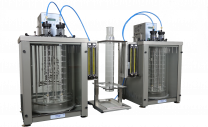ASTM D892
These test methods (ASTM D892 - IP 416 - ISO 6247) cover the foaming characteristics of lubrication oils at 24°C and 93.5°C. The tendency of oils to foam can be a serious problem in systems such as high-speed gearing, high-volume pumping, and splash lubrication. Inadequate lubrication, cavitation, and overflow loss of lubricant can lead to mechanical failure. These test methods are used in the evaluation of oils for such operating conditions.




